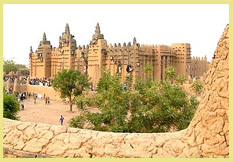




Ngorongoro Conservation Area - Tanzania

Website Category: Human Origins
Area: 8,288 km2
Inscribed: 2010 (cultural criteria)
Criteria: (iv) icon of an era (Also natural criteria)
Location and Values: The Ngorongoro Conservation Area is located on the west flank of the Great Rift Valley in northern Tanzania, and forms part of the Serengeti ecosystem. Besides its outstanding natural attributes (shown here), the area has made an exceptional contribution to our understanding of human evolution. Fossil evidence from various locations within the Conservation Area, notably Olduvai Gorge, provides a remarkably complete picture spanning a period of almost four million years.
One of the most remarkable finds was a series of hominid footprints (known as the ‘Laetoli’ footprints), preserved in wet volcanic ash, that proved that our ancestors (Australopithecus afarensis) were walking upright long before anyone had imagined – some 3.75 million years ago. An earlier find, made in 1959 by anthropologists Louis and Mary Leakey, of skull fragments from the 1.75 million year old ‘Nutcracker Man’ (Zinjanthropus boisei), was thought at the time to provide a key ‘missing link’ in the human evolutionary line (but it subsequently turned out that this species was an evolutionary dead end). Other hominid fossil discoveries from Olduvai Gorge (including specimens of Homo habilis, Homo erectus and Homo sapiens) provide further evidence of key events in the human evolutionary story. Elsewhere in the Conservation Area other important finds include an early form of Homo sapiens at Lake Ndutu; and evidence of the development of stone technology and the transition to the use of iron in Ngorongoro Crater.
Slideshow of Ngorongoro Conservation Area (cultural elements): The slideshow presents a series of photographs showing some cultural aspects of the Ngorongoro Conservation Area, focussing on the extraordinary fossil finds of Olduvai Gorge and neighbouring areas. Some of the exhibits in the small museum at Olduvai are shown, including a cast of the famous ‘Laetoli footprints’, a selection of stone tools, and the fossilised remains of extinct mammals that once roamed the East African Plains alongside our hominid ancestors. The life of the present-day Maasai inhabitants of Ngorongoro is also illustrated with a selection of photos of their manyattas (homesteads), lifestyle and environment. For more pictures, focussing on the wildlife and natural attributes of the area, click here..
Comments and Impressions: Ngorongoro Conservation Area is scenically spectacular, culturally fascinating and supports (for part of the year) the greatest wildlife migration on Earth. It was one of the first natural world heritage sites to be listed in Africa, while its outstanding cultural attributes were only formally recognised in 2010 when it was also listed under a world heritage cultural criterion. It is now one of only five African ‘mixed’ sites to satisfy both natural and cultural criteria.
Google Earth View: To view satellite imagery of the Olduvai Gorge paleaontological site on Google Earth, click here. This opens a new window, so when you are finished, just close the Google Earth page and you will be straight back here to continue browsing. You can learn an enormous amount from this kind of ‘bird’s eye view’, so take a few minutes to explore the surroundings by panning in and out, and looking to left and right at high resolution. Panning to the southeast of Olduvai you should be able to see Ngorongoro Crater, while Lake Ndutu is off to the west.

Want to know more?
Download this 14-page guide to the key hominin fossils found across the continent, and the story of human origins and evolution. The Guide is based on displays at the National Museum of Kenya (Nairobi) and includes a narrative on human evolution; photos of 19 key hominin fossils; artists impressions of four human ancestors; a map of hominin fossil locations; a diagrammatic representation of the human family tree; and 'interest boxes' on stone tools and methods of dating fossils. To download this free educational guide, click here.
Links to other places in the human origins category: Awash Valley I Omo Valley I Sterkfontein
Other Links: Official UNESCO Site Details




.jpg)